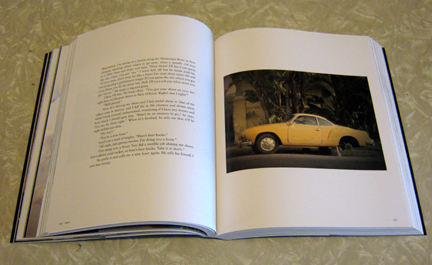This is a story about being a man in America.
More specifically, it’s about me being a man in America. Or trying.
 With those opening words by James A. Reeves begins a most unusual memoir. The sprawling “The Road to Somewhere” (412 pages, $25 retail price, softcover, W.W. Norton) is part autobiography, part travelogue, part photo book. Its candid writing will enthrall some readers, and infuriate others. But it’s not boring, and it’s certainly thought-provoking.
With those opening words by James A. Reeves begins a most unusual memoir. The sprawling “The Road to Somewhere” (412 pages, $25 retail price, softcover, W.W. Norton) is part autobiography, part travelogue, part photo book. Its candid writing will enthrall some readers, and infuriate others. But it’s not boring, and it’s certainly thought-provoking.
The book contains more than 200 color photographs, many of them shot by Reeves. A number are color-saturated and nostalgia-inducing family photos of the 1960s and ’70s.
But most are moody images captured from the backroads of America — a lonely gas station at night, a single Airstream trailer in the desert, a buckshot-riddled highway sign, or young men getting into a brawl beneath the Santa Monica Pier. The images, despite their often-vivid colors, often convey a film-noir quality.
The book is divided into chapters titled Men, County, Work, Home, Discipline, God, Guts, and Strength. The length of Reeves’ written entries in “The Road to Somewhere” varies widely — a fair number contain just one or two sentences, but one entry (about a chaotic day helping a first-grade teacher) goes for nine full pages.
Although “The Road to Somewhere” meanders on subject matters, the book ultimately focuses on Reeves’ lineage. His great-grandfather overcame a rough childhood in Canada and established a fishery in Michigan and served as a postmaster general. His grandfather enlisted in the military during World War II, started a family, and spent decades working at Sears. Reeves’ father enlisted during Vietnam, started a family, and worked for Sears for 13 years — until he was laid off and forced to take more-menial jobs.
Reeves didn’t go into the military, and bounced from job to job throughout his 20s. Troubled by his own aimlessness and that he’s “a million miles away from my father and grandfather,” Reeves takes to the road to “figure out what I’m made of.”
All told, he drives through about 45 states and more than 40,000 miles. A good portion of his travels turn into a blur of exhaustion, talk radio surfing, cheap hotels, and unsettling or odd experiences. But he finds comfort in the desolate spaces of the Mojave Desert and U.S. 50. He finds contentment while listening to customers chat in a Waffle House.

And his observations from the road often turn perceptive. During a visit to South of the Border in South Carolina, he notes it “might be one of the ickiest parts of America, but it’s one of the most brilliantly marketed. I stopped.”
In other hands, “The Road to Somewhere” might have devolved into poseur prose. But Reeves’ humility keeps that from happening. That lack of pretension — plus his observant eye — keep you reading.
“The Road to Somewhere” seems to flitter about as aimlessly as its author until a series of tragedies strike Reeves’ family while he is living abroad. This snaps him out of his ambivalence about his home country and returns the book to some focus:
Here’s how I thought this book would end: after moving to Finland for a year or two, I began to see America in a brighter, clearer light. Although my country continued to frustrate me, I found myself missing the people, the diversity, the chaos, the earnestness. I prepared to return.
In the end, “The Road to Somewhere” leads to some reconciliation with his country and himself. On the backroads, he discovered the good, the bad, and the ugly of America. He wouldn’t have his homeland any other way, and he found out a lot about himself because of his experiences.
Not coincidentally, his experiences sound a lot like mine during and after all my first long journey on Route 66. So Reeves’ book struck a chord.
Recommended.